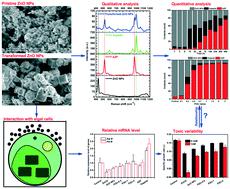当前位置:
X-MOL 学术
›
Environ. Sci.: Nano
›
论文详情
Our official English website, www.x-mol.net, welcomes your feedback! (Note: you will need to create a separate account there.)
Study of the toxicity of ZnO nanoparticles to Chlorella sorokiniana under the influence of phosphate: spectroscopic quantification, photosynthetic efficiency and gene expression analysis
Environmental Science: Nano ( IF 7.3 ) Pub Date : 2020-03-17 , DOI: 10.1039/c9en01464k Hong Zhang 1, 2, 2, 3, 4 , Zhu Chen 1, 2, 2, 3, 4 , Qing Huang 1, 2, 2, 3, 4
Environmental Science: Nano ( IF 7.3 ) Pub Date : 2020-03-17 , DOI: 10.1039/c9en01464k Hong Zhang 1, 2, 2, 3, 4 , Zhu Chen 1, 2, 2, 3, 4 , Qing Huang 1, 2, 2, 3, 4
Affiliation

|
Zinc oxide nanoparticles (ZnO NPs) are one of the most abundantly applied nanomaterials in nanotechnology-based industries, and recent research continues to highlight their potential eco-toxicity especially to aquatic environments. When they enter into a water environment, their physicochemical transformations may result in largely unknown end products and induce additional potential toxicity. Although previous studies have documented the transformation of ZnO NPs, there is still a lack of the in-depth understanding of the corresponding variant toxicities of the pristine and transformed ZnO NPs to aquatic organisms, particularly demanding the quantitative analysis of the physicochemical transformations to distinguish their contributions in the toxicity assessment. For this purpose, therefore, we initiated a study of the toxicity of transformed ZnO NPs in phosphate containing water to a model aquatic microalga, i.e., Chlorella sorokiniana, with the aid of spectroscopic tools for characterization and quantification of the physicochemical transformations, and we scrutinized the toxicity variations of ZnO NPs transformed in different P/Zn molar ratios. The possible toxicity mechanisms were investigated, especially those related to the influence of photosynthesis efficiency of the algae cells. As a result, we found that the toxicity of transformed ZnO NPs in phosphate water to the green algae was lower than that of the pristine ZnO NPs. With spectroscopic tools such as XRD and Raman spectroscopy, we made both qualitative and quantitative assessments of the physicochemical changes of the ZnO NPs and revealed that for the pristine ZnO NP group, the toxicity stemmed mainly from the release of zinc ions from the pristine ZnO NPs, while in the presence of phosphate, the neoformation of the nanoparticles played a critical role, leading to the overall reduced toxicity due to the less toxic amorphous zinc phosphate (AZP) and hopeite (Zn3(PO4)2·4H2O) in the transformed compounds. Besides, the mechanism of the toxicity of phosphate induced transformations of ZnO NPs to C. sorokiniana was also verified by the analysis of gene expression involved in photosynthesis. Our results showed that the expressions of the photosynthesis associated genes were depressed by the treatment of pristine ZnO NPs, while the expressions of the related genes were up-regulated in the groups of hopeite and AZP, indicating that the soluble phosphate had profound effects on algal photosynthesis, and thus affected the algal toxicity of ZnO NPs in the aqueous environment. These newly acquired results will certainly elaborate our knowledge on the fate and effects of ZnO NP transformation in aquatic environments.
中文翻译:

磷酸盐对ZnO纳米粒子对小球藻的毒性研究:光谱定量,光合效率和基因表达分析
氧化锌纳米颗粒(ZnO NPs)是基于纳米技术的行业中应用最广泛的纳米材料之一,最近的研究继续强调其潜在的生态毒性,尤其是对水生环境的毒性。当它们进入水环境时,它们的理化转化可能会导致最终未知的最终产物并引起其他潜在的毒性。尽管先前的研究已记录了ZnO NP的转化,但仍缺乏对原始和转化的ZnO NP对水生生物的相应变异毒性的深入了解,特别是需要对理化转化进行定量分析以区分它们在毒性评估中的贡献。因此,为此,即,小球藻,借助用于表征和定量理化转化的光谱工具,我们研究了以不同P / Zn摩尔比转化的ZnO NPs的毒性变化。研究了可能的毒性机制,特别是那些与藻类细胞光合作用效率的影响有关的机制。结果,我们发现,磷酸盐水中转化的ZnO NPs对绿藻的毒性低于原始ZnO NPs。我们使用XRD和拉曼光谱仪等光谱学工具对ZnO NP的理化变化进行了定性和定量评估,并发现对于原始ZnO NP组,毒性主要来自于原始ZnO NP释放的锌离子。 ,而在有磷酸盐的情况下,3(PO 4) 2 ·4H 2 O)。此外,磷酸盐诱导ZnO NPs转化为梭状芽胞杆菌的毒性机理参与光合作用的基因表达分析也证实了这一点。结果表明,原始ZnO NPs抑制了光合作用相关基因的表达,而在希望组和AZP组中相关基因的表达上调,表明可溶性磷酸盐对藻类具有深远的影响。光合作用,因此影响了ZnO NP在水环境中的藻类毒性。这些新获得的结果无疑将使我们更加了解水生环境中ZnO NP转化的命运和影响。
更新日期:2020-03-17
中文翻译:

磷酸盐对ZnO纳米粒子对小球藻的毒性研究:光谱定量,光合效率和基因表达分析
氧化锌纳米颗粒(ZnO NPs)是基于纳米技术的行业中应用最广泛的纳米材料之一,最近的研究继续强调其潜在的生态毒性,尤其是对水生环境的毒性。当它们进入水环境时,它们的理化转化可能会导致最终未知的最终产物并引起其他潜在的毒性。尽管先前的研究已记录了ZnO NP的转化,但仍缺乏对原始和转化的ZnO NP对水生生物的相应变异毒性的深入了解,特别是需要对理化转化进行定量分析以区分它们在毒性评估中的贡献。因此,为此,即,小球藻,借助用于表征和定量理化转化的光谱工具,我们研究了以不同P / Zn摩尔比转化的ZnO NPs的毒性变化。研究了可能的毒性机制,特别是那些与藻类细胞光合作用效率的影响有关的机制。结果,我们发现,磷酸盐水中转化的ZnO NPs对绿藻的毒性低于原始ZnO NPs。我们使用XRD和拉曼光谱仪等光谱学工具对ZnO NP的理化变化进行了定性和定量评估,并发现对于原始ZnO NP组,毒性主要来自于原始ZnO NP释放的锌离子。 ,而在有磷酸盐的情况下,3(PO 4) 2 ·4H 2 O)。此外,磷酸盐诱导ZnO NPs转化为梭状芽胞杆菌的毒性机理参与光合作用的基因表达分析也证实了这一点。结果表明,原始ZnO NPs抑制了光合作用相关基因的表达,而在希望组和AZP组中相关基因的表达上调,表明可溶性磷酸盐对藻类具有深远的影响。光合作用,因此影响了ZnO NP在水环境中的藻类毒性。这些新获得的结果无疑将使我们更加了解水生环境中ZnO NP转化的命运和影响。


























 京公网安备 11010802027423号
京公网安备 11010802027423号